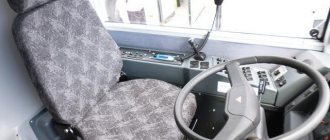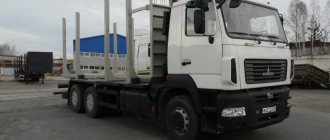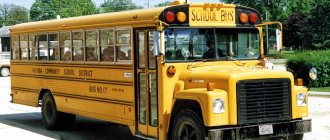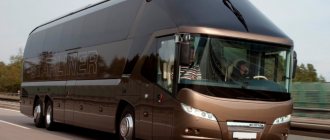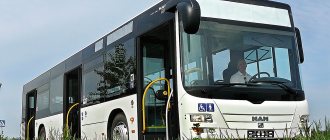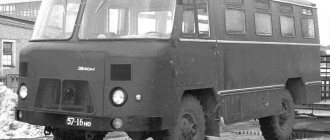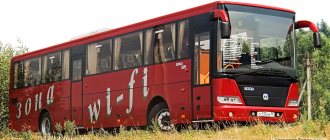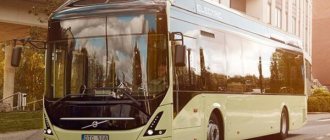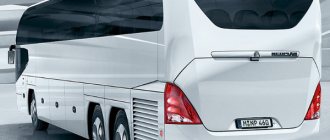Home Brands MAZ MAZ-107
MAZ-107 is a single-section bus with three axles, which belongs to the class of especially large ones. Operation of the bus is prohibited, both in the manufacturing country, the Republic of Belarus, and in Russia. The exception is the city of Moscow, which has a huge passenger flow. The city authorities studied the merits of the bus and adopted it.
The model is very similar to the MAZ-103, which is built on the basis of simple engineering solutions, which made it possible to simplify the design of the new model and reduce its cost. The first presentation took place in 2001, at which time the first copies rolled off the assembly line. The model was restyled in 2008. Restyling was planned, as a result of which changes occurred in the design, interior, and technical defects were significantly corrected, which made the model even more reliable.
Dimensions
The uniqueness of the MAZ-107 bus lies precisely in its dimensions. Extra-large class buses enjoyed great success in European countries, particularly in Germany, in the 90s, as there was constantly high passenger traffic there. A company from Minsk also borrowed this idea. As a result, the bus received an all-metal monocoque body, which was equipped with three sliding doors. The front half of the front double door for the driver.
Dimensions:
- It boasts its length, which is slightly short of 15 meters and is 14,480 mm;
- The bus has a standard width for all models of the line - 2,500 mm;
- Height – 3,210 mm;
- The total weight is 24,100 kg. Most of the mass is taken by the middle axle of the bus - 11,500 kg.
Rigid chassis
Body South Pacific Scania K113TRBL Four Axle Bus 14.5 m (47 ft 7 in) in Canberra ACT
Three Axle Double Decker Buses
common in high-capacity work environments where articulated buses are not used, such as Hong Kong and Singapore. Three-axle buses are also widely used in Dublin, Ireland. Imported three-axle buses were originally used by Megabus for low-cost, high-capacity intercity travel in the UK.
Three-axle double-decker buses
were used to accommodate excess weight. The models are also being implemented on intercity routes with high capacity, for example by the operator. Megabus.
A coach with dual steering
This is a rare type of three-axis trainer; where the twin axles are at the front and are steered like the Bedford VAL or Bustech CDi.
The Neoplan Megaliner was the first four-axle double-decker bus
, and is used in Japan. Additional examples include the Scania K380IB 8x2.
Cabin interior
Most buses with these dimensions had an accordion mechanism, which significantly affected the layout and convenience of passengers. This is not the case here. The salon itself has a 3-row arrangement of seats. Two chairs on the left and one on the right. There are large storage areas in the door area, and pneumatic actuators are also available for the doors, which passengers can use to open them in the event of an accident. Above each seat of the MAZ-107 there is a “stop on demand” button. Once the bus stops, the driver will not have to open the doors. It is enough for him to give permission to exit, and he himself will open the door closest to the passenger’s seat.
The interior materials are quite acceptable, the fabric upholstery creates special comfort.
The driver's seat is well equipped, the steering wheel does not block the view of the controls, and an abundance of various signals and indications will promptly report any malfunction.
The driver's seat in most cases is protected by a plastic partition, however, in the Moscow modifications there is no such option.
The bus can be either city or suburban. In the second case there is a 4-row layout. The first modification has 24-29 seats, and the total passenger capacity is up to 140 people.
The second modification has 36 seats, and the total capacity is limited to 115 passengers.
Articulated chassis
Three axle bus trailer East Lancs healthy Volvo B9TL three axle double decker bus to the united kingdom
The three axle axle is a standard arrangement of two parts. articulated buses.
Articulated buses sometimes use a four-axle arrangement to support the extra weight of the bodies, as in this four-axle articulated bus
The Volvo articulated bus[
permanent dead link
], and
the double-decker four-axle articulated bus
, the Neoplan Jumbokruiser.
The four-axis unit is also an exclusive three-piece option. double-articulated buses
.
Rare reason[ quote needed
] why a bus can have several axles in the case of a bus trailer, where the passenger cabin of the bus is made in the form of a semi-trailer body and is towed by a separate tractor.
Technical characteristics of MAZ-107
The bus is available with 6-cylinder diesel power units with turbocharging and a common rail fuel injection system.
The base engine is Daimler OM 906LA, the volume of which is 6.4 liters, and the maximum power it develops is 285 hp and torque is 1120 Nm.
The second engine is the Daimler OM 926LA, the volume of which is increased to 7.2 liters and the power is 326 hp. Torque increased to 1,300 Nm.
The car is equipped with two different automatic transmissions – Voith Diwa or Allison. They transfer all the power to the middle axle, and the bus accelerates to 110 km/h.
The suspension of the bus is all-round dependent, and is based on pneumatic cylinders: in front - two cylinders, in the rear - four. The steering is complemented by a hydraulic booster, and the brakes are a drum system with pneumatic drive.
Reasons for using multiple axes
The Bedford VAL was a dual-steer coach whose extra axle allowed the use of smaller, lighter wheels and a lower floor height.
Typically, the vehicle licensing authorities of various countries set legal limits on the amount of weight that can be carried on each axle. In the UK, recent extensions to the legal duration limit of rigid buses and coaches have led to the increased use of three axles to accommodate heavier chassis and passenger loads. Some countries apply vehicle exemptions for certain operations.
Additional axles can also be installed on shorter buses and coaches to accommodate additional equipment such as passenger elevators, or amenities such as restrooms, televisions, and climate control. In addition, in some cases there is a need for cargo buses when large cargo compartments and heavy cargo weights require additional axles.
Adding axles to a chassis design is done for certain reasons, such as weight or legality, since having additional axles means additional costs for the operator in terms of tire replacement, and to some extent, higher fuel consumption.
On some buses, the rearmost axle is connected to the steering, with the rear of the steering in the opposite direction to the front axle. This steering arrangement allows longer three-axle buses to negotiate corners with greater ease than would otherwise be the case.
Model description
MAZ-107 has been produced for more than ten years (since 2001). During this time, a large number of improvements were made to the design of the bus (for example, improved interior layout; steering third axle and others). MAZ-107 has a number of features. MAZ-107 is a city bus, which is designed to transport a large number of passengers and operate on routes with large passenger traffic. The length is 14.48 meters; The turning radius, however, is relatively small (about 13 meters). The design of the bus is similar to the Neoplan N4020, produced by Neoplan Polska (now called Solaris Bus & Coach
), since it is a further evolution of models 103 and 101, which, in turn, were created on the basis of N4014.
Body
The basis of the bus body is a rigid frame made of high-strength galvanized steel pipes, onto which all components and assemblies are attached. The frame is integrated into the body and serves to strengthen the entire structure. The outer cladding is made of high-strength galvanized steel sheets, which reduces the risk of corrosion. The body has a service life of at least 10 years. The wheel arches of the MAZ-107 bus are made of stainless steel and are also completely treated with anti-corrosion enamels as one of the most susceptible areas to corrosion.
The bus can have either a classic look (in the photo) or a slightly modified look of the front and rear panels (for example, instead of single headlights, several separate ones or replacing a large black bumper with a smaller one that merges with the body), while the interior and driver’s seat remain the same. The MAZ-107 does not have a standard paint job.
Front
The layout of the front end is as follows: the casing is made of galvanized steel sheet, and later lined with a fiberglass shell. The windshield of the bus is made of a large double-glazed window, divided into two parts, which, nevertheless, provides the driver with a high level of visibility; The sides are lined with rubber profiles. Shatterproof windshield: a double-glazed window consists of two layers of glass glued together with a thin transparent layer of polymer, the function of which is to hold glass fragments in case of damage.
Bus windshield wipers are three-speed, parallelogram type, equipped with large blade nozzles and clean the maximum possible surface of the windshield. A windshield washer function is provided, when foam is sprayed onto the glass from a tank (or tanks) located under the front end trim.
Headlights and bumper
In the classic version of the MAZ-107, the lighting equipment on the front end is represented by two square lampshades with several headlights in each: fog lights, low beam and high beam. The headlights are equipped with lenses. Unlike the MAZ-105, in the classic version of the MAZ-107, the fog lights are not built into the bumper, but are placed together with others in the ceiling. The bumper on most modifications is large and black.
In the updated version of the MAZ-107, the head lighting equipment is represented by eight individual headlights of small size and round shape. The main beam headlights are located in the middle of each head optics unit. The large black bumper has been replaced by a compact, body-colored steel bumper of a new design with integrated fog lights.
Other front end elements
The emblem of the Minsk Automobile Plant is located in the middle of the front end. In many classic versions, the inscription “MAZ 107” is located directly under the windshield; This almost never happens in new models.
Other markings on the front:
- an image of a person in a wheelchair on a blue background, indicating that the bus is equipped with the necessary devices for transporting passengers in wheelchairs (optional);
- symbol with a man with a cane (rare): indicates that the bus is suitable for pensioners and people with limited mobility.
The front route indicator is located above the windshield of the bus. On the first versions of the bus these are simple signs; on most of today's MAZ 107 buses it is electronic. Electronic route indicators may vary: the early version is a board with separate cells for each symbol, the updated version is a solid blinker-type board with pale yellow or pale green symbols. The side mirrors are spherical, electrically heated, and (sometimes) anti-reflective.
The rear panel has also been restyled: the taillights are now separate, rounded, vertically positioned instead of the horizontal and rectangular ones previously; The back window of the bus is tinted.
Engine and transmission
The engine compartment of the MAZ 107 bus is located in the rear overhang, located longitudinally on the left and occupies the entire space from bottom to top - the engine compartment, known as the “cabinet,” is located in the cabin.
MAZ 107 can be equipped with various engine models. In early versions, Belarusian-made MMZ engines were installed. A French-made Renault MIDR engine was also installed, but it turned out to be weak for this rather massive bus. New copies are equipped with diesel engines MAN D0826 (MAN, Germany), Mercedes-Benz OM906LA II and Mercedes-Benz OM906LA III (Mercedes-Benz, Germany); Other models are also possible. All of them are usually four-stroke, six-cylinder with a total displacement of 6.37 liters and comply with environmental standards Euro-2, Euro-3 and Euro-4. The bus's fuel tank holds 220 liters; The fuel tank cap is located on the right side. The engine cooling system includes two air absorbers: in the left side panel and on the rear panel; under the first of them there is a hatch for additional cooling.
The bus can be equipped with an automatic transmission from Voith, a manual MAZ, as well as transmissions from other manufacturers.
Suspension and steering
The bus is three-axle. The third axle of the bus has a steering effect, which is activated by pressing a button in the driver's cabin. The bus axles are manufactured by a German company; the driving axle is central.
There is a differential lock, which makes it easier to start on difficult surfaces (ice, compacted snow) and is a rarity for buses of this class, even on a global scale.
The front and central axle suspension is independent pneumatic; rear suspension - pneumatic dependent. As an additional option, a Lincoln
(Germany), eliminating the need to lubricate all parts manually.
The steering of the MAZ-107 is unified with other first-generation MAZs and is equipped with a hydraulic booster.
Bus brake system
- service brake
, dual-circuit (divided into circuits along the axis);
drum brake mechanisms- engine brake
(used for braking on descents). The principle is to stop the supply of fuel to the engine cylinders while simultaneously blocking the exhaust gas outlet. - The parking brake system
is represented by a manual tap acting on the brake mechanisms of the drive axle. The hand tap is small, shaped like a joystick; - ABS
: Knorr-Bremse or WABCO anti-lock braking system; - ASR
(anti-traction system).
Salon
Access to the interior of the MAZ-107 bus is provided by three double doors with a large glazing area, tinted safety glass units; The door compartments are made of galvanized steel and coated with an anti-corrosion coating. Rarely, the MAZ 107 can be equipped with a system that prevents pinching of passengers and blocks the movement of the bus when the doors are open.
In most MAZ buses, including MAZ-107, one of the front door wings is separated from the passenger compartment and serves as access to the driver's cabin. In some modifications of the MAZ-107, the entire front door is reserved for passengers and belongs to the interior space.
The bus is semi-low-floor: in most of the cabin the step height is 33.5 centimeters, but from the middle door to the rear of the cabin the floor level increases to 58 centimeters. Kneeling system
allows the bus to “squat” by 6 centimeters, making it easier to enter the cabin.
The floor of the cabin is covered with a single sheet of gray linoleum, sometimes with glitter. Non-flammable materials (for example, heat-resistant plastic) are used in the interior decoration, and in the event of a significant increase in temperature, special aerosol capsules located in the sidewalls are activated. The handrails are made of steel pipe coated with polymer paint to ensure corrosion resistance. Vertical handrails are thin, straight or curved (sometimes), attached to the floor of the cabin or using brackets to the seat handles. Horizontal railings stretch along the entire length of the cabin and can be equipped with special hanging handles made of rubber, leather substitute or other materials.
The side windows of the bus are tinted. An information board can be installed in the bus interior to display information about the flight, date, etc. The bus has fairly developed ventilation and heating systems. The first is standardly represented by sliding windows placed on the side windows; Ventilation hatches are built into the roof of the cabin. Electric fans or air conditioning are available as options (including in the driver's cabin).
The heating system is connected to the engine cooling system. There are from one to three air electric convector heaters located in the cabin, and a separate convector is installed in the driver’s cabin.
The MAZ-107 is equipped with an autoinformer, but there is also a microphone in the driver’s cabin.
Passenger seats
Bus seats can be made of various materials. Seats upholstered in synthetic fabric in various colors are standard. The standard seats have a fully synthetic backrest and cushion, while the rear backrest and passenger handle are made of plastic. All-plastic seats made from non-flammable plastic are available.
The interior of the 107th MAZ has a three-row layout - there are three seats per row, where there are two seats to the left of the central aisle and one to the right, so the number of seats does not exceed 25-31. In suburban versions, a four-row layout is possible (two seats on the right and left; the number of seats increases to 51).
The total passenger capacity of the MAZ-107 is approximately 150 people, which is comparable to the capacity of the two-section MAZ-105 of 170 people.
Opportunities for disabled people
Optionally, the bus can be equipped with a ramp to provide access to the cabin for people in wheelchairs.
Cabin and driver's seat
The driver's cabin is completely separated from the passenger compartment by a partition; for entry and exit, the driver is assigned the front half of the front door, which opens autonomously. In some modifications, the front doors are completely reserved for passengers. The closed driver's cabin is quite spacious.
The plastic dashboard of the bus has the shape of an arc and is available in black or dark gray. The panel provides quick access to all controls. On its right side there is a set of keys with which the doors are opened and closed, with a function for simultaneous closing of all doors and two separate buttons for opening and closing the driver's cab door. There are also control keys for the automatic transmission, a light switch and fog lights, as well as a toggle switch for the engine brake, control buttons for the autoinformer and a key for turning on the hazard lights. The left section contains keys for turning on the interior and driver's lights, heating, ABS, ASR and other functions.
To the left of the driver there is an additional panel where the parking brake joystick and some other levers and buttons are located.
In the middle of the dashboard there is a speedometer with a large VDO dial, digitized to 125 km/h with an integrated electronic odometer. To the right of the speedometer is the tachometer, digitized to 30x100 crankshaft revolutions per minute. To the right of the tachometer are the fuel level indicator, pressure gauge and coolant temperature indicator. To the left of the speedometer there is another pressure gauge, as well as an on-board voltage indicator.
There are two steering column levers: the left one is used to turn the turn signals on and off, the right one controls the operation of the windshield wipers. The instrument and starter switch is located in the steering column. The driver's seat is soft and comfortable, equipped with air suspension and height adjustment. The movement of the bus is controlled using two or three pedals, depending on whether it is equipped with an automatic or manual transmission, respectively.
The bus uses a 28-volt car generator. 1 air convector is used to heat the driver’s cabin; the side rear-view mirrors are also equipped with electric heating; The new MAZ-107 buses also offer air conditioning for the driver.

